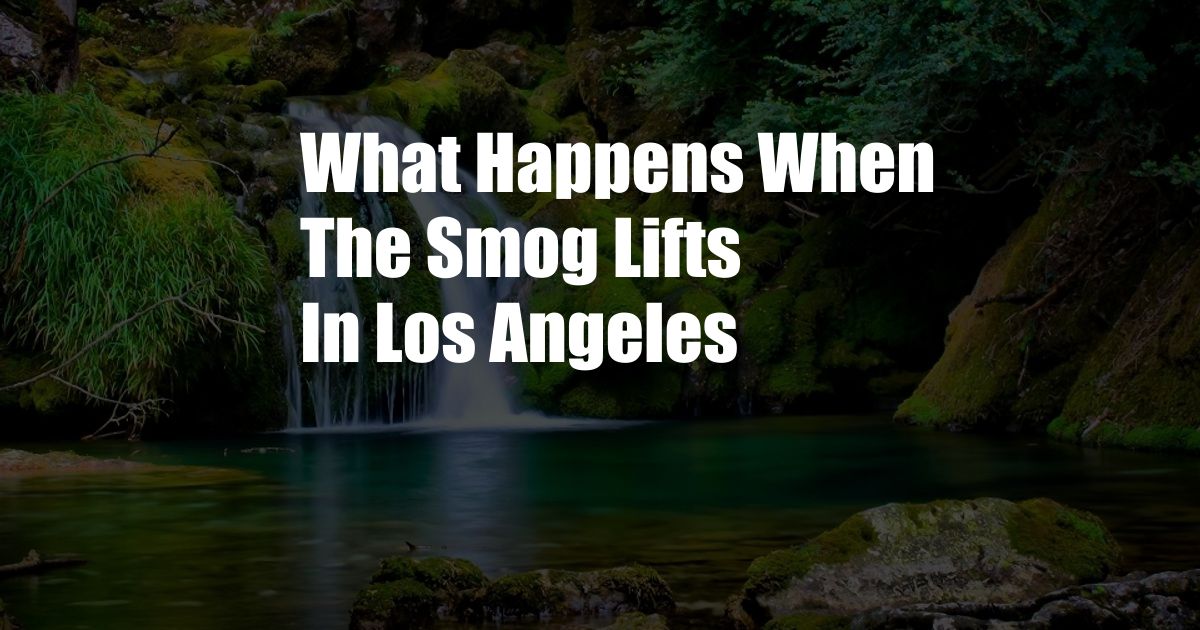
Unveiling the Transformation: What Happens When the Smog Lifts in Los Angeles
In the sprawling metropolis of Los Angeles, known for its vibrant entertainment industry and iconic landmarks, the city’s air quality has been a persistent concern. The dense smog that often blankets the region can have a significant impact on the health and well-being of its inhabitants. But what happens to the city and its people when the smog finally clears?
As the oppressive haze lifts, a remarkable transformation takes place. The once-dreary skyline glistens with vivid clarity, revealing the majestic San Gabriel Mountains that have long been obscured by pollution. The sun radiates with newfound intensity, casting a warm embrace upon the sprawling cityscape below. The streets, once choked with traffic and smog, now breathe with a sense of ease and tranquility.
A City Reborn
With the air purified, the city’s true beauty emerges. The leaves of trees, once coated in a film of grime, now shimmer with vibrant hues of green. The vibrant colors of flowers burst forth in full bloom, painting the streets in a kaleidoscope of shades. The iconic palm trees that line the boulevards sway gently in the breeze, their fronds reaching for the clear blue sky.
The transformation is not just aesthetic. The air itself becomes invigorating, filling the lungs with a refreshing purity. The persistent cough and labored breathing that have plagued many residents begin to subside. As the smog dissipates, so too do the health concerns associated with its presence.
A Breath of Fresh Air
The absence of smog has a profound impact on the health of Los Angeles residents. Studies have shown that long-term exposure to air pollution can increase the risk of respiratory illness, cardiovascular disease, and even cancer. When the smog lifts, these risks diminish, allowing residents to breathe more easily and live healthier lives.
The benefits extend beyond physical health. The improved air quality also contributes to mental well-being. Reduced exposure to pollutants has been linked to lower levels of stress, anxiety, and depression. With clearer minds and lighter hearts, Angelenos can fully embrace the vibrant and stimulating city that surrounds them.
The Impact on the Environment
The disappearance of smog has a ripple effect on the environment as well. The absence of pollutants in the air reduces the formation of ozone, a harmful gas that can damage plant life. As a result, vegetation thrives, contributing to a greener and more sustainable city.
The improved air quality also benefits wildlife. Birds, which are particularly sensitive to air pollution, can now sing and fly more freely. Insects, bees, and other pollinators flourish, ensuring the continued vitality of the local ecosystem.
Tips for Embracing Clear Skies
While the occasional lift in smog is a welcome respite, it is important to remember that air pollution remains a persistent challenge in Los Angeles. Fortunately, there are steps that individuals can take to minimize their exposure and contribute to cleaner air.
Consider using public transportation, walking, or biking instead of driving whenever possible. Opt for low-emission or electric vehicles if you must drive. Reduce your energy consumption by turning off lights and appliances when not in use. Support businesses that prioritize sustainability and waste reduction.
Expert Advice
Experts in the field of environmental health emphasize the importance of long-term strategies to address air pollution in Los Angeles. They recommend investing in renewable energy sources, promoting sustainable transportation options, and strengthening regulations on emissions from vehicles and industries.
By working together, individuals and policymakers can create a future where the smog lifts not just for a day, but for good. Los Angeles has the potential to become a beacon of clean air, a vibrant and healthy city where its residents can thrive in harmony with the environment.
FAQs on Smog in Los Angeles
Q: Why is Los Angeles so prone to smog?
A: Los Angeles is located in a basin surrounded by mountains, which trap pollutants released from vehicles, factories, and other sources. The region’s sunny weather and lack of wind contribute to the formation of smog.
Q: What are the health effects of smog?
A: Smog can cause a range of health problems, including respiratory irritation, asthma, cardiovascular disease, and cancer. Long-term exposure to smog can also shorten life expectancy.
Q: What can I do to reduce my exposure to smog?
A: Check air quality forecasts and try to stay indoors when smog levels are high. Limit outdoor activities during rush hour and on hot, sunny days. Use an air purifier in your home or car.
Q: What is being done to improve air quality in Los Angeles?
A: The government has implemented a number of measures to reduce air pollution, including stricter vehicle emissions standards, the promotion of electric vehicles, and investments in renewable energy.
Conclusion
The lifting of smog in Los Angeles is a transformative experience that brings clarity, health, and vibrancy to the city. By embracing sustainable practices and working towards long-term solutions, Angelenos can ensure that the clear skies become a permanent fixture in their beloved metropolis. Are you ready to join the movement for a smog-free Los Angeles?